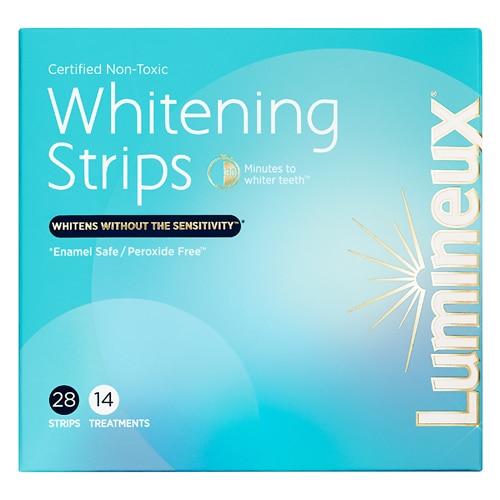[vc_row][vc_column][vc_column_text]Would you be surprised to learn that, according to one national surve
y, fully
80 percent of American adults ages 18-49 want whiter teeth? That helps to explain why teeth whitening is one of the most popular cosmetic dental procedures. In fact, the
global teeth whitening market, valued at $8.52 billion in 2024, is projected to reach $12.77 billion by 2032.

According to the American Dental Association (ADA),
teeth whitening products typically contain hydrogen peroxide or carbamide peroxide. These bleaches break stains into smaller particles, so the pigment is less concentrated, resulting in brighter teeth. Some people get their teeth whitened professionally, whereas others opt for over-the-counter teeth whitening products, including whitening toothpaste, strips, gels and rinses.
Professional teeth whitening methods include sanding down stains, bleaching, ultraviolet (UV) light therapy and more, but the two
primary types of whitening procedures are vital whitening, which is an in-office procedure involving a strong whitening gel along with a specialized light to facilitate the bleaching process, and non-vital whitening, which targets intrinsic staining on teeth during root canal procedures.
What are the risks of traditional teeth whitening procedures?
The typical ways of whitening teeth can sometimes lead to gum irritation, which occurs when a whitening agent comes into direct contact with the soft tissues of the mouth, causing irritation, which may manifest as redness, swelling or tenderness in the gums. Another s
ide effect associated with teeth whitening is increased tooth sensitivity, since whitening agents, especially those containing peroxide, can penetrate the enamel and irritate the nerves inside the tooth, making teeth especially sensitive to hot and cold temperatures.
Another risk associated with traditional teeth whitening products and procedures is exposure to harmful ingredients, such as:
- Chlorine dioxide – Found in some teeth-whitening products, this powerful oxidizer can strip away tooth enamel, compromising the protective layer of your teeth. This may lead to increased sensitivity and a higher risk of tooth decay.
- Hydrogen peroxide – While it can effectively whiten teeth, high concentrations of hydrogen peroxide can lead to gum irritation and tooth sensitivity.
- Sodium chlorite – This common ingredient can damage tooth enamel, leading to increased tooth sensitivity and even permanent enamel loss.
- Carbamide peroxide – This chemical breaks down into a more potent form of hydrogen peroxide to whiten teeth, which can cause gum irritation and tooth sensitivity.
- Ammonium hydroxide – This caustic compound, found in some teeth-whitening solutions, can erode enamel, leading to tooth sensitivity and even tooth damage.
- Parabens – These are often used as preservatives in teeth-whitening products but may be harmful as they appear to disrupt the body's hormonal balance. Parabens are considered endocrine-disrupting chemicals (EDCs).
How to whiten teeth naturally
If you prefer a more natural approach to a brighter smile, free of the less-than-inviting chemicals listed above, you will be glad to know there is a wealth of comparatively healthy avenues, from lifestyle habits to product options, including:
Fruit and veggies
Fresh produce supports a healthy, bright smile in several ways. For one, according to folk medicine, rubbing orange, banana, or lemon peels over the surface of your teeth for a minute or two before brushing may help with lightening, due to the naturally occurring citric acid in the peels.
Additionally, eating crunchy produce helps to clear plaque from your teeth. while you chew them. Pineapple and strawberry are especially beneficial, as pineapple contains bromelain, an enzyme that effectively removes stains and is useful in overall tooth whitening, and strawberries, featuring
malic acid, which works like a natural astringent and helps remove tooth surface discoloration.
Oil pulling
This traditional remedy, originating in India, has been shown to improve oral hygiene and promote a healthy smile. The practice involves dissolving a small amount of coconut oil in your mouth and swishing it around to remove bacteria, which can turn into stain-attracting plaque. Coconut oil is high in lauric acid, which is known for its ability to reduce inflammation and kill bacteria. Along with reducing bacteria, daily oil pulling may also
guard against plaque and gingivitis.
To try this method, simply place a spoonful of organic coconut oil in your mouth, pushing and pulling the oil through your teeth as it melts. Continue the practice for 15–20 minutes, discarding the oil in a trash can as it can otherwise firm back up and block your drain.
DIY Baking soda and hydrogen peroxide paste
Baking soda is slightly abrasive, so it gently buffs stains from teeth, while hydrogen peroxide acts as a natural bleaching agent, which also kills bacteria. Hydrogen peroxide has nearly the same molecular structure as water (H2O). The difference is that it contains an additional atom of oxygen; therefore, its chemical name is H2O2.
To try: Combine one tablespoon of baking soda with two tablespoons of
food grade hydrogen peroxide such as
SunFood Food Grade Hydrogen Peroxide, which is suitable for DIY oral care products. You can also make a whitening oral rinse by diluting this whitening paste with water. Limit yourself to once or twice a week for safest results.
Xylitol-based oral care products
As one study noted, xylitol, a five-carbon sugar polyol, may help
reduce the risk of dental cavities because xylitol inhibits the growth of Streptococcus mutans, a bacteria responsible for tooth decay. Xylitol also supports tooth remineralization by promoting the absorption of calcium and phosphate ions.
Xylitol's biggest benefit may be that the
oral bacteria which can cause diseases like gingivitis are unable to consume it like normal sugar. Relying on
gum,
mints,
toothpaste and
mouthwash with xylitol helps to starve out bacteria in your mouth. Xylitol also supports healthy inflammation levels, which is beneficial since oral inflammation is a contributing factor to gum disease.
Natural teeth whitening product solutions
This fluoride-free formula features Nano-Hydroxyapatite (N-HA) to support sensitive teeth and help remineralize enamel.
An effervescent formula with natural whitening power, this toothpaste is also vegan and free of fluoride, parabens and SLS.
Progressive dentists are reporting that most toothpastes are overly abrasive and erode enamel, making low-abrasion options a smart choice, especially before and after whitening treatments. For best results, use
Organic BR Toothpaste daily and the
BR Tooth Polish for extra brightening, perhaps a few times per week or month.
This Ayurvedic formula, made with coconut oil, plus lavender, oregano, thyme, cinnamon, clove & peppermint and vitamins D3, E & K2, is ideal for your daily oil pulling practice.
These cruelty-free, vegan whitening strips with a reduced sensitivity whitening formula offer measurably whiter teeth in a 30 minute treatment, helping to removes stains from coffee, tea, wine, and more. You may also like the super convenient
Zimba Teeth Whitening Pen for travel and on-the-go.
With an alcohol-free and sugar-free formula, this extra strength oral rinse contains oxygen-releasing molecules plus potent xylitol, grapefruit seed extract, and hydrogen peroxide for an ultra-clean mouth.
How to maintain your freshly brightened smile
The easiest and most effective way to keep teeth pristine after whitening treatments is to avoid the foods and beverages most likely to cause stains and discoloration, which include coffee, tea, wine, tobacco products, and brightly pigmented foods such as beets, pomegranates and turmeric. However, since many people consume these items daily, the next best step is to mitigate their capacity to stain by rinsing your mouth with water after consuming them, or better yet, swishing with a
xylitol-based mouthwash.
Again, along with regular dentist visits and daily brushing and flossing, it’s important to manage deeply pigmented foods and drinks, rinsing well after enjoying them. As for daily care, you have a bouquet of natural options to help you achieve your healthiest, brightest smile?naturally.[/vc_column_text][/vc_column][/vc_row][vc_row][vc_column][vc_text_separator title="Featured Products" border_width="2"][vc_row_inner equal_height="yes" content_placement="middle" gap="35"][vc_column_inner width="1/3"][vc_single_image image="181936" img_size="full" alignment="center" onclick="custom_link" img_link_target="_blank" css=".vc_custom_1738433935104{padding-right: 7% !important;padding-left: 7% !important;}" link="https://www.vitacost.com/zimba-teeth-whitening-strips-spearmint"][/vc_column_inner][vc_column_inner width="1/3"][vc_single_image image="181935" img_size="full" alignment="center" onclick="custom_link" img_link_target="_blank" css=".vc_custom_1738433954078{padding-right: 7% !important;padding-left: 7% !important;}" link="https://www.vitacost.com/lumineux-oral-essentials-whitening-strips-28-strips-14-treatments"][/vc_column_inner][vc_column_inner width="1/3"][vc_single_image image="181934" img_size="full" alignment="center" onclick="custom_link" img_link_target="_blank" css=".vc_custom_1738433972105{padding-right: 7% !important;padding-left: 7% !important;}" link="https://www.vitacost.com/dr-gingers-coconut-oil-whitening-pen"][/vc_column_inner][/vc_row_inner][/vc_column][/vc_row]
 According to the American Dental Association (ADA), teeth whitening products typically contain hydrogen peroxide or carbamide peroxide. These bleaches break stains into smaller particles, so the pigment is less concentrated, resulting in brighter teeth. Some people get their teeth whitened professionally, whereas others opt for over-the-counter teeth whitening products, including whitening toothpaste, strips, gels and rinses.
Professional teeth whitening methods include sanding down stains, bleaching, ultraviolet (UV) light therapy and more, but the two primary types of whitening procedures are vital whitening, which is an in-office procedure involving a strong whitening gel along with a specialized light to facilitate the bleaching process, and non-vital whitening, which targets intrinsic staining on teeth during root canal procedures.
According to the American Dental Association (ADA), teeth whitening products typically contain hydrogen peroxide or carbamide peroxide. These bleaches break stains into smaller particles, so the pigment is less concentrated, resulting in brighter teeth. Some people get their teeth whitened professionally, whereas others opt for over-the-counter teeth whitening products, including whitening toothpaste, strips, gels and rinses.
Professional teeth whitening methods include sanding down stains, bleaching, ultraviolet (UV) light therapy and more, but the two primary types of whitening procedures are vital whitening, which is an in-office procedure involving a strong whitening gel along with a specialized light to facilitate the bleaching process, and non-vital whitening, which targets intrinsic staining on teeth during root canal procedures.




